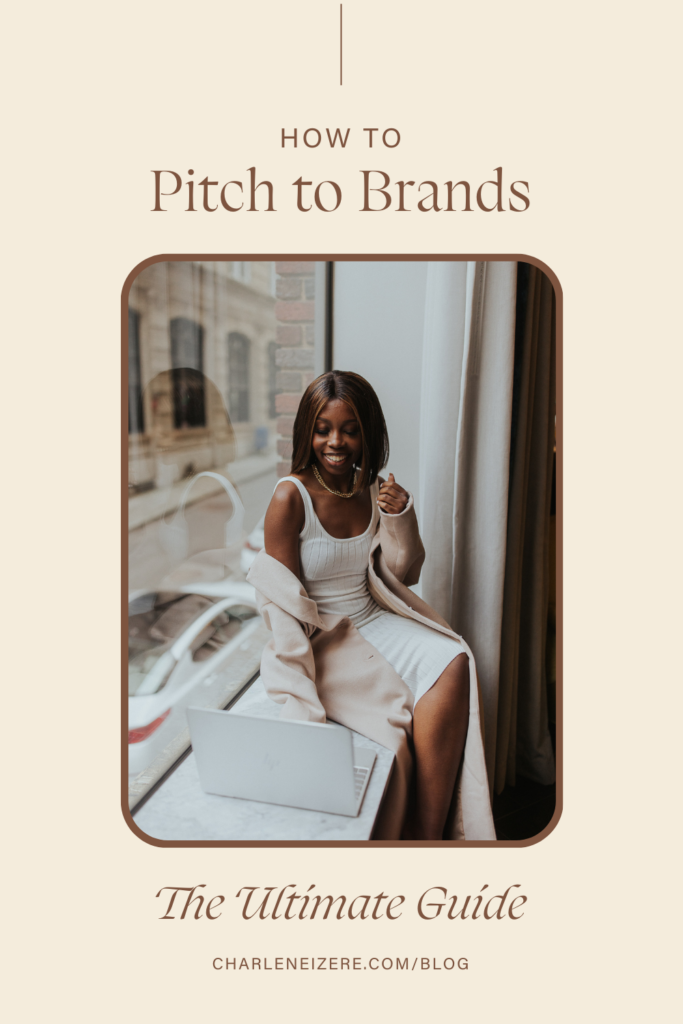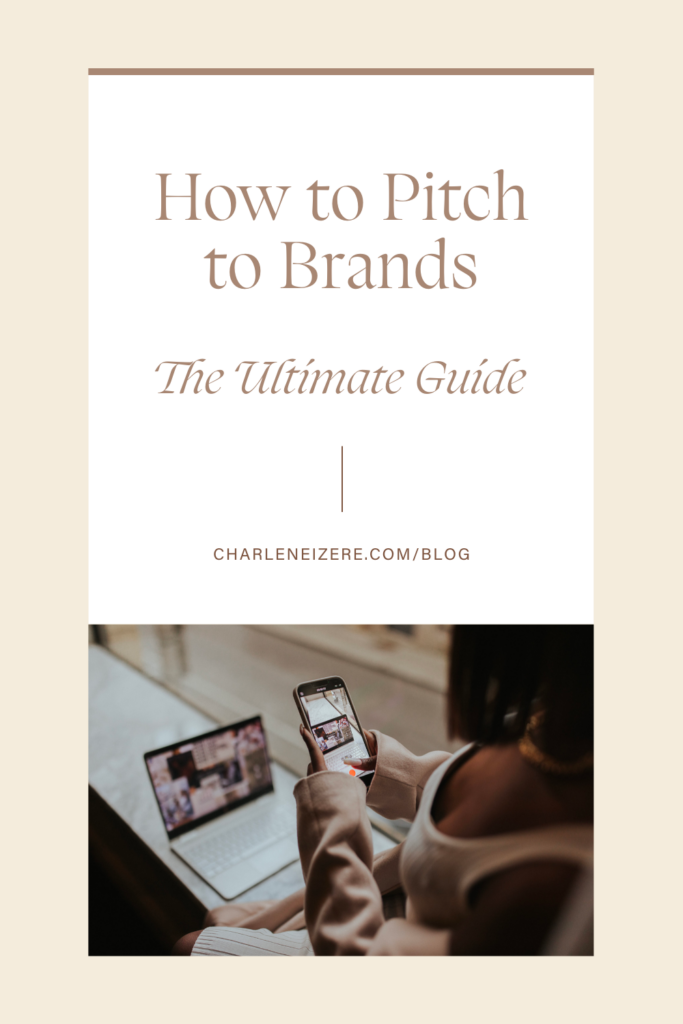About
Hi, I'm Charlene Izere. I'm a fulltime content creator with a love for video editing, aesthetics, productivity, and education. My content includes a mixture of creator behind the scenes, motherhood musings, and creator education. Stay a while, I know you'll love it here.
How to Pitch to Brands: A Creator’s Guide with Email Templates
How many times have you poured your heart into creating content, updating your UGC portfolio, and sending out countless pitches, only to receive gifted collaborations or low-ball offers? I’ve been there, feeling frustrated and wondering if there’s a better way to pitch to brands.
When I first started pitching to brands as a content creator and influencer, I had no idea what I was doing. I didn’t know what to include in the pitch or how to stand out and set myself apart. I often asked myself, “now what?” after hitting send, and my follow-up game was weak, to say the least.
My lack of knowledge cost me many opportunities and left lots of money on the table. I’ve now sent and received countless pitches, and I’m landing four-figure and 5-figure deals. You won’t have to go through the growing pains I did, because luckily for you, I’m spilling the tea on how to pitch to brands effectively.
So how do you pitch to brands as a UGC Creator or Nano-Influencer?
It boils down to understanding how to pitch to brands effectively. In practice it looks something like this, crafting a pitch that highlights your content creation skills, demonstrates your alignment with their target demographic, showcases your engaged community, or emphasizes your subject matter expertise, and leverages a strong portfolio to prove your value.
Your next brand collaboration is on the other side of this blog post. I’ll walk you through the ins and outs of how to pitch to brands so you can land the collaborations of your dreams and secure the bag. Now let’s get into it.
Why Your Pitch Matters
A great pitch is crucial in securing brand collaborations. It’s your opportunity to highlight your unique value and align with what brands are seeking. Here’s what you need to focus on:
- Content Creation Skills: Demonstrate your ability to produce high-quality, engaging content that resonates with audiences. For UGC creators, this means showcasing your talent in crafting user-generated content that captures the brand’s essence and engages their target audience.
- Demographic Match: Illustrate how you align with the brand’s target demographic. Whether you’re a mom pitching to a baby brand or a fitness enthusiast reaching out to a protein shake company, make this connection clear.
- Community Engagement: Highlight your engaged community. A smaller, highly engaged audience can be more valuable than a large, passive one. For UGC creators, showcasing your community’s engagement can demonstrate how effectively your content resonates.
- Subject Matter Expertise (SME): Showcase your niche knowledge and skills. Are you a makeup artist pitching to a beauty brand or a tech reviewer approaching a gadget company? Let your expertise shine.
- Strong Portfolio: This is crucial for all creators, but especially for UGC creators and those with smaller followings. Your portfolio is your secret weapon. A well-curated UGC portfolio can prove your value to potential brand partners and demonstrate your ability to create compelling content.
How to Pitch to Brands: Preparing Your Pitch Strategy
Before you craft your pitch, you must do the groundwork.
This looks like initiating contact with the brand to develop a genuine relationship. Brands want to work with creators and influencers who genuinely care about their mission, products, and overall goals. In this age of superficial social media, authenticity is key. If you slide into their inbox without establishing any sort of relationship, chances are your pitch won’t make it past the subject line.
Pro Tip: Establish these relationships 2-3 weeks before your formal pitch. Don’t just slide into their DMs on the same day, they will see right through you.
So how do you initiate contact and foster a relationship? Post about them on social media & tag them in your posts. It begins in the DMs and goes down in the inbox. Keep it natural and show them how their products or services fit seamlessly into your life. Right now you’re simply letting them know that you’re into them.
It begins in the DMs and goes down in the inbox

Bonus points if you engage with their social media account and create relevant content with their products. Brands pay attention to these kinds of things, and they absolutely love a creator and influencer who walks the walk. If you can’t get your hands on their product, create content about a relevant product in their niche – this will come into play when we talk about your pitch.
Audit Your Social Media Presence
How to Pitch to Brands: Leveraging Your Online Presence
Even if you aren’t pitching based off of your community, your personal brand will help (even with 100 followers). While you are establishing relationships with brands, take some time to audit your online presence. Below are key things to keep in mind as you conduct your social media audit:
- Do you have relevant content on your socials?
- Do your social media accounts clearly describe you, your community, and what you offer?
- Is there cohesion amongst all of your platforms?
Always keep your online presence up to date and relevant – if the hiring manager loves your pitch, the first thing they do is examine your profile, especially if you have them linked in your signature.
Stay ready so you don’t have to get ready.
The Importance of a Strong UGC Portfolio
For UGC creators, a strong portfolio is essential. Unlike a media kit, which is more relevant for pitching to your community, a UGC portfolio showcases your best work and demonstrates your ability to create content that drives engagement and conversions. Here’s how to build and present a compelling UGC portfolio:
- Showcase a Variety of Work: Include different types of content, such as images, videos, and written posts, to highlight your versatility. Make sure each piece of content is well-organized and categorized.
- Highlight Key Metrics: For each piece of content in your portfolio, include relevant metrics such as engagement rates, reach, and conversions. This data helps potential brand partners understand the impact of your content.
- Include Case Studies: If possible, include case studies that show how your UGC has driven results for previous brands. Detail the challenge, your approach, and the outcomes.
- Keep it Updated: Regularly update your portfolio with new content and metrics. An up-to-date portfolio demonstrates that you are active and relevant in your field.
How to Pitch to Brands: Do you need a Media Kit?
If you are pitching your community, in addition to a portfolio, you’ll want to have a media kit. A media kit serves as your digital business card and gives people an instant look into what you are all about. Keep it on brand and visually appealing.
What should you include in your media kit?
- About Section: With the brand’s interest in mind – What do you want the brands to know about you?
- Testimonials: Include receipts. This could be messages from your community saying that they bought x item or testimonials from past partnerships.
- Examples: link examples of your past work, your writing & video samples
- Your Stats: Play to your strengths and include your best stats
Pro tip #1: Don’t use the same template that every influencer uses – chances are the influencer manager has seen it.
Pro tip #2: Don’t put your rates in your media kit – ask for their budget before you share your rate sheet.
Plan Your Pitch Strategy
How to Pitch to Brands: Crafting Your Unique Angle
Before you craft your pitch, it’s crucial to determine your angle: are you pitching as an influencer, a content creator, or both? Each approach has its distinct focus and requires a tailored strategy.
- Content Creation Skills: If you’re pitching as a content creator, highlight your ability to produce high-quality, engaging content that resonates with audiences. Showcase examples of your work that demonstrate how you bring unique storytelling to written, audio, or visual formats. Brands want to see how you can creatively represent their products or services.
- Demographic Match: Whether you’re pitching as an influencer or a content creator, it’s essential to illustrate how your audience aligns with the brand’s target demographic. For instance, if you’re a mom pitching to a baby brand, make it clear how your content and community are a perfect match. Similarly, if you’re a fitness enthusiast reaching out to a protein shake company, emphasize this alignment.
- Community Engagement: Highlight your community’s engagement level. For both influencers and content creators, it’s not just about the size of your following but the quality of interactions. Demonstrate how your engaged audience is responsive and interacts meaningfully with your content. Brands often value a smaller, highly engaged audience over a large, passive one.
- Subject Matter Expertise (SME): Showcase your expertise in your niche. Whether you’re a makeup artist pitching to a beauty brand or a tech reviewer approaching a gadget company, let your specialized knowledge and skills shine. Brands are looking for creators who can authentically and effectively communicate their message within a specific industry or topic.
Determine Your Unique Angle
After establishing your approach, pinpoint what makes you unique. What sets you apart from others pitching to the same brand?
- Content Creator: Focus on how your content creation skills can provide a fresh perspective or unique storytelling that aligns with the brand’s vision.
- Influencer: Emphasize how your community’s interests and needs make you an ideal partner for promoting the brand’s products or services.
- Both: Combine your content creation skills with your influential reach to demonstrate how you can produce compelling content that will resonate with and engage your community.
Your Angle: Content Creator + Influencer
✨ Your Unique Identifier: I utilize captivating transitions in my video content
✨ Your Strengths: I’m an expert in leveraging long-form content to create short-form videos.
Your Angle: Influencer
✨ Your Unique Identifier: My community trusts my opinions and often buys from my blog posts.
✨ Your Strengths: Strong Engagement Rate and Active Community
So you’ve crafted your pitch, now let’s take it to the next level.
How to Make Your Pitch Stand Out as a Content Creator and Influencer
Influencer & Creator Marketing Managers receive hundreds of pitches a day, so your number one job is to capture and keep their attention.
Here are 5 strategies to elevate your pitch so you can finally master how to pitch to brands
- Create a mood board for each pitch. Customize the mood board to the brand and your campaign ideas.
- Hyperlink relevant content you’ve created about their product (or a product related to their industry).
- Create a pitch video. If you are a content creator or influencer, you know that video isn’t going anywhere. A video pitch is guaranteed to catch attention amongst a sea of written pitches, so use this to your advantage. But make sure to keep it concise and no longer than 60 seconds.
- Use creative concepts that have a sense of urgency. (for example a seasonal collaboration)
- Be an early adopter of trends and social media features. Use that as a leverage point in your pitch.
How to Format Your Collaboration Pitch Email
How to Pitch to Brands: The Ultimate Pitch Email Format
Crafting an email involves knowing how to pitch to brands with the right subject lines and content. Starting with the subject line, it determines whether your email gets opened or overlooked. There are two main approaches to subject lines: “instant open” and straightforward. Each has its merits, so let’s break down their differences and effectiveness.
Instant Open Subject Lines
Example: “My community is obsessed with your moisturizer!”
Pros:
- Attention-Grabbing: Instant open subject lines are designed to capture immediate attention. They often include a compelling hook or an element of curiosity, which encourages the recipient to open the email to learn more.
- Personalization: By referencing your community’s interest in the brand’s product, you create a sense of relevance and urgency. This personalization helps the brand see that you have a genuine connection with their product and that your pitch is not a generic mass email.
- Emotionally Engaging: These subject lines often evoke an emotional response or spark curiosity, making the recipient more inclined to open the email. They create a sense of excitement or intrigue about what’s inside.
Cons:
- Risk of Over-Promising: If the content of your email doesn’t deliver on the promise made in the subject line, it can lead to disappointment and reduce your credibility.
- Potential for Spam Filters: Some subject lines that are too sensational might trigger spam filters, which could prevent your email from reaching the intended recipient.
Best Practices:
- Be Genuine: Ensure that your subject line accurately reflects the content of your email. Authenticity is key to maintaining trust.
- Test Variations: A/B test different instant open subject lines to see which ones resonate best with your audience and achieve higher open rates.
Straightforward Subject Lines
Example: “Char x Brand”
Pros:
- Clarity: Straightforward subject lines clearly state the purpose of the email, making it easy for the recipient to understand at a glance. This can be effective if the recipient is already familiar with you or your work.
- Professionalism: A direct approach can come across as professional and to-the-point. It avoids any gimmicks or embellishments, which can be appealing in a business context.
- Expectations Setting: By being clear and concise, straightforward subject lines set accurate expectations about the email’s content, reducing the risk of disappointment.
Cons:
- Less Engaging: These subject lines might not stand out in a crowded inbox, especially if they don’t offer any unique or compelling element to grab attention.
- Missed Opportunity for Hook: A straightforward subject line doesn’t leverage the opportunity to pique curiosity or create emotional engagement, which could impact open rates.
Best Practices:
- Be Clear and Direct: Ensure that the subject line is simple yet informative. If you’re pitching a collaboration, make it clear in the subject line.
- Include Relevant Details: Incorporate key information such as your name and the brand to provide immediate context.
Which to Use?
The choice between an instant open and a straightforward subject line depends on several factors:
- Brand Relationship: If you have an established relationship with the brand or if the brand is already familiar with your work, a straightforward subject line might be more appropriate. It provides clarity and sets professional expectations.
- New Outreach: For new outreach, an instant open subject line can help you stand out and catch the recipient’s attention, especially if you’re trying to make a memorable first impression.
- A/B Testing: Experiment with both approaches to see which resonates better with your target audience. Track open rates and engagement metrics to refine your strategy over time.
Moving on to the body of your pitch, briefly greet the Influencer Manager/Social Media Manager in the first line (bonus points if you are addressing a specific person), and introduce yourself.
Hi [Name]!
I hope you had a great weekend. I’m Charlene, a Luxury Content Creator, and I can’t explain to you how much my community and I LOVE your [insert product].
In 2-3 sentences tell them why you love their product. Brands want to work with influencers and creators who can authentically capture their essence and tell a compelling story. Again, we’ll want to keep this brief.
Since giving birth, my skin has been so problematic. Once I started using [insert product] though, my skin cleared up, and I’m finally feeling like myself again. I shared my journey with my community, and they’ve had similar experiences. [insert relevant screenshots].
Now show them your numbers (if you have them). Show them why they should care about you, and give them a reason to keep reading. There’s a good chance the influencer or creator partnerships manager is skimming through your email in a hurry, and they may go straight here.
My community makeup
- Follower Count
- Demographic
- Engagement Rate
- Unique Selling Point Stat
Pro tip: Use stats that play to your strength. Maybe your following count is less than 5k, but your engagement rate is 10% – hype it up and show your best self. At the end of the day, solid engagement almost always beats follower count.
Share your unique pitch
Last month I shared my nighttime skincare routine and my community couldn’t get enough of your Mattifying Moisturizer. [Insert Screenshots] I’m currently preparing for a summer family vacation, and I’d love to collaborate on a Jetlag Skincare Routine featuring the [insert brand product]. I’ve attached a mood board for this potential partnership.
Let me know your thoughts!
Note that in this template, we aren’t sharing our media kit yet, but we are sharing important heavy hitter stats. If and when they respond back, that’s when you’ll share your media kit.
How to Pitch to Brands: The Follow Up
Your work isn’t done after you hit the send button. In fact, this is just the beginning. Knowing how to pitch to brands includes effective follow-up strategies.
If you don’t hear back from them after a short while, don’t be afraid to reach back out and slide into their inbox.
Sometimes the collaboration begins with the second or third follow-up. Include a personal touch when following up – this could be something you noticed on their social media, something they shared in their weekly newsletter etc. Basically, let them know you are still into them and that you’d love to pursue a partnership.
Remember, pitching is a process – you’ll get lots of no’s, but you’ll also get tons of aligned yesses.
Protip: If a brand says no, continue to engage with the brand to keep you at the top of their mind for when the time is right.
Conclusion
Just like writing a resume or doing job interviews, pitching to brands is a skill. The more you practice, the easier it becomes and the better you get. If you go in with the goal of creating a genuine connection instead of simply landing a gig, you’ll win every time. These connections often turn into lucrative partnerships vs one-off collaborations as well.
To recap:
- Initiate contact with the brand and establish a relationship on social media,
- Audit your online presence,
- Create and update your media kit,
- Craft your unique pitch,
- Send your Pitch,
- Follow Up
We live in a world where creators and influencers are more trusted than organizations so go secure the bag and pitch the brand. Who is your dream collab?
Loved this post? Pin it for later!


Leave a Reply Cancel reply
Search the blog
About
Hi, I'm Charlene Izere. I'm a fulltime content creator with a love for video editing, aesthetics, productivity, and education. My content includes a mixture of creator behind the scenes, motherhood musings, and creator education. Stay a while, I know you'll love it here.
Categories
Follow On
© 2023 Charlene Izere ALL RIGHTS RESERVED
I'll see you on the 'gram
BRAND + SITE DESIGN BY HIGHFLIER POWERHOUSE
